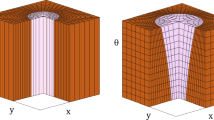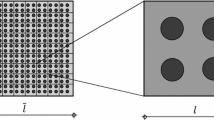Abstract
This article presents the details of a numerical technique for computing the macroscopic response of a material with a given micro-structure to arbitrary prescribed loading histories. The method uses classical concepts of homogenisation theory in combination with the finite element method and focusses on the computation of macroscopic yield surfaces and inelastic strain rates. It places no restrictions on the magnitude of deformation and allows arbitrary combinations of stress- or strain control including the prescription of histories of the Cauchy stress. The method is illustrated by analysing a model material, consisting of a non-linearly elastic matrix with stiff elasto-plastic inclusions, which exhibits macroscopically associative elasto-plastic material behaviour with finite elastic strains. Yield surfaces and the directions of plastic flow after a prior finite simple shear deformation are computed for this material and are shown to be consistent with an additive decomposition of the Eulerian strain rate into elastic and plastic parts and a suitable formulation of the normality rule in Cauchy stress space; a novel version of the latter is derived which is valid for an arbitrary reference configuration.
Similar content being viewed by others
References
Adhikari R, Huy T, Buschnakowski M, Knoll K (2004) Asymmetric ps-block-(ps-co-pb)-block-ps block copolymers: morphology formation and deformation behaviour. New J Phys 6: 28
Chen Y, Kulasegaram S (2009) Numerical modelling of fracture of particulate composites using sph method. Comput Mater Sci 47: 60–70
Gürses E, Becker M, Miehe C (2004) Numerical computation of anisotropically evolving yield surfaces based on micro-to macro transitions. Proc Appl Math Mech 4: 219–220
Halphen B, Nguyen Q (1975) Sur les materiaux standards generalises. J Mechanique 14: 39–63
Hill R (1972) On constitutive macro-variables for heterogeneous solids at finite strain. Proc R Soc London A 326: 131–147
Hill R (1978) Aspects of invariance in solid mechanics. In: Yih CS (ed) Advances in applied mechanics, vol 18. Academic Press, San Diego
Hill R (1984) On macroscopic effects of heterogeneity in elastoplastic media at finite strain. Math Proc Camb Phil Soc 95: 481–494
Hill R, Rice J (1973) Elastic potentials and the structure of inelastic constitutive laws. SIAM J Appl Math 25(3): 448–461
Il’yushin AA (1961) On a postulate of plasticity. Prikl Mat Mech 25: 503–507
Kouznetsova V, Brekelmans W, Baajens F (2001) An approach to micro-macro modelling of heterogeneous materials. Comput Mech 27: 37–48
Mehrabadi M, Nemat-Nasser S (1987) Some basic kinematical relations for finite deformation of continua. Mech Mat 6: 127–138
Miehe C, Koch A (2002) Computational micro-to-macro transitions of discretized microstructures undergoing small strains. Arch Appl Mech 72: 300–317
Miehe C, Schröder J, Schotte J (1999) Computational homogenization analysis in fintie plasticity. Simulation of texture develpopment in polycristalline materials. Comput Meth Appl Mech Eng 171: 387–418
Pardoen T, Hutchinson J (2000) An extended model for void growth and coalescence. J Mech Phys Solids 48: 2467–2512
Prakash A, Lebensohn R (2009) Simulation of micromechanical behavior of polycrystals: finite elements versus fast fourier transforms. Modelling Simul Mater Sci Eng 17:1–16(064010)
Rice J (1971) Inelastic constitutive relations for solids: an internal variable theory and its application to metal plasticity. J Mech Phys Solids 19: 433–455
Schmidt I (2004) Deformation induced anisotropy in metal foams—modelling and simulation. Int J Solids Struct 41(24–25): 6759–6782
Schmidt I, Trondl A, Wonisch A, Kraft T (2010) Simulation of the material behaviour of metal-powder during compaction. J Process Mech Eng 224: 187–194
Temizer I, Wriggers P (2008) On the computation of the macroscopic tangent for multiscale volumetric homogenization problems. Comput Meth Appl Mech Eng 198: 495–510
Yuan Z, Fish J (2008) Toward realization of computational homogenization in practice. Int J Numer Meth Eng 73: 361–380
Author information
Authors and Affiliations
Corresponding author
Additional information
Dedicated to Prof. Dietmar Gross on his 70th birthday.
Rights and permissions
About this article
Cite this article
Schmidt, I. Numerical homogenisation of an elasto-plastic model-material with large elastic strains: macroscopic yield surfaces and the Eulerian normality rule. Comput Mech 48, 579–590 (2011). https://doi.org/10.1007/s00466-011-0601-x
Received:
Accepted:
Published:
Issue Date:
DOI: https://doi.org/10.1007/s00466-011-0601-x




